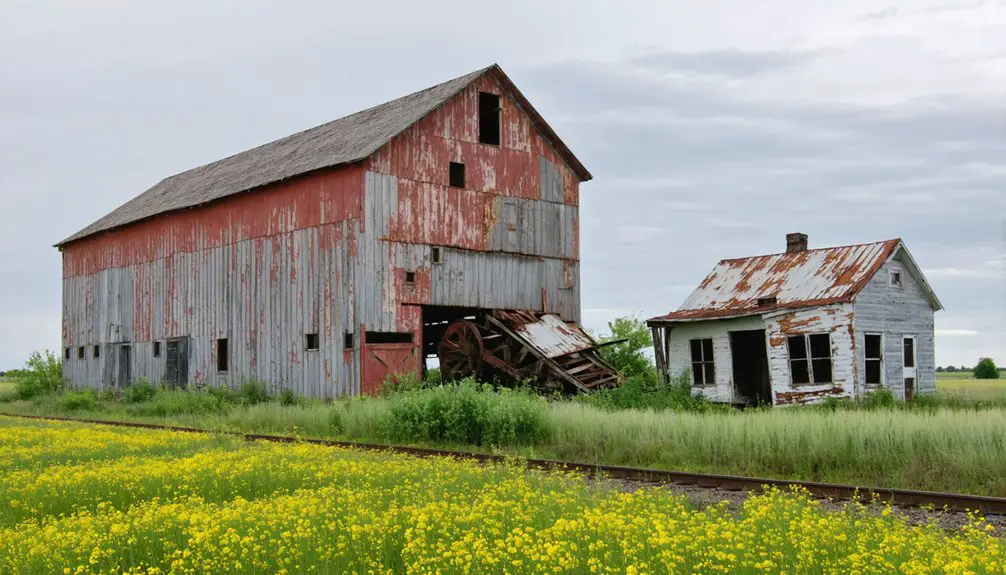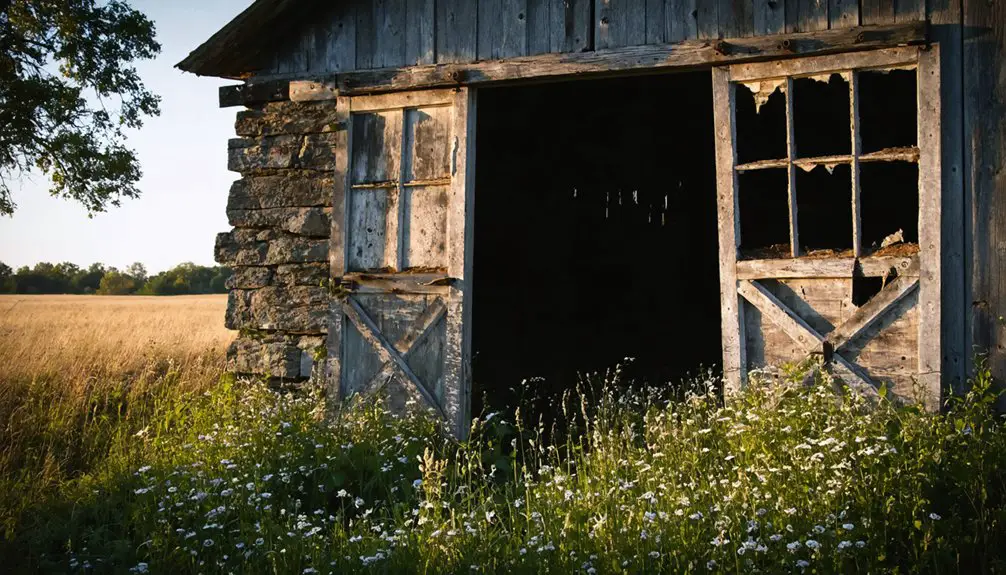You’ll find Mitchell’s ghostly remnants in Wexford County, Michigan, where William W. Mitchell founded a bustling lumber empire in the 1870s. The town flourished with Finnish immigrants, company-owned stores, and a massive sawmill operation that processed 80,000 feet of lumber daily. After the timber industry’s decline, Mitchell transformed from a vibrant community of 1,200 residents into an abandoned settlement. The weathered foundations and overgrown paths hold fascinating stories of Michigan’s golden age of lumber.
Key Takeaways
- Mitchell began as a logging town in 1883, founded by the Mitchell brothers before being renamed to Jennings in 1890.
- The town flourished during Michigan’s lumber era, reaching its peak population of 1,200 residents in 1917.
- Cobbs & Mitchell Lumber Company dominated the town’s economy, controlling housing, stores, and employment for residents.
- Finnish immigrants formed the backbone of the community, establishing cooperative stores and cultural centers to preserve traditions.
- The town’s decline followed the end of Michigan’s lumber boom, leaving Mitchell as a historically significant ghost town today.
The Birth of a Lumber Empire
While many lumber empires rose and fell in 19th century Michigan, few matched the strategic brilliance and rapid expansion of the Cobbs & Mitchell Lumber Company.
In Michigan’s competitive lumber trade, Cobbs & Mitchell stood apart through unmatched strategic vision and explosive growth.
You’ll find the roots of this empire in William W. Mitchell’s early ventures into Wexford County’s pineries, where he’d spend over three decades mastering the lumber trade.
The company’s bold moves defined its success – they acquired 276 acres of pine land and claimed stakes in key sawmills, including their crown jewel: an 80,000-feet-per-day facility built in Cadillac in 1892.
Their mastery of timber transportation set them apart, with strategic railroad connections and innovative canal systems linking waterways. Mitchell’s father’s experience as a Michigan Southern Railroad contractor influenced these transportation developments. The devastating Great Michigan Fires damaged many competing timber operations, further solidifying the company’s dominance.
Even after Cobbs’ death in 1898, the reorganized company under Mitchell’s leadership continued to dominate lumber production, cementing their legacy in Michigan’s golden age of timber.
From Mitchell to Jennings: A Name’s Evolution
While you’d recognize the town today as Jennings, its origin story began in 1883 when the Mitchell brothers established their logging operation and named the settlement after themselves.
You’ll find that the town’s identity shifted in 1890 when postal authorities required a name change to avoid confusion with another Mitchell in Michigan’s Antrim County.
The new name “Jennings” paid tribute to politician William Jennings Bryan, marking a turning point in the community’s evolution from a simple lumber camp to an established township. The name reflected the era’s common practice of using English-language surnames for newly established settlements. The town experienced significant growth with the creation of mills on Crooked Lake, transforming it into a bustling hub of industry.
Original Town Founding
In 1871, George A. Mitchell purchased and platted what you’d recognize as the original site of Clam Lake village. His founding significance became clear as he transformed dense pine forest into a carefully planned community. You would’ve seen nothing but survey markers and blaze-marked trees before Mitchell’s ambitious vision took shape. By 1872, the settlement had grown to include 300 residents with roughly 60 families calling it home.
Mitchell’s community vision went far beyond basic town planning. He laid out major street lines using Little Clam Lake as the western boundary, while incorporating business districts, residential lots, and public spaces. The completion of the Clam Lake Canal in 1873 proved crucial for transporting logs and connecting the waterways.
You’ll appreciate how he provided free lots for churches, gifted land for a cemetery, and reserved a block for county buildings. By year’s end, the central village area had been cleared, marking the beginning of rapid development that would shape this frontier settlement.
Name Change Necessity
The peaceful existence of Mitchell faced an unexpected challenge in 1890 when postal authorities highlighted a significant naming conflict.
You see, another Michigan town in Antrim County had already claimed the name Mitchell, creating confusion in postal delivery and railroad operations.
The name significance of this small lumber town required immediate attention, as historical documentation shows the establishment of a new post office demanded a unique identity.
The solution came in honoring William Jennings Bryan, a prominent political figure of the era.
This strategic renaming accomplished two important objectives: it resolved the postal delivery confusion and aligned the community with the Jennings & Northeastern Railroad that served the area.
The shift simplified logistics for both mail service and rail transport, marking a pivotal moment in the town’s development.
The town’s prosperity peaked during this period, with peak population of 2,000 making it a bustling hub of industry.
Honoring William Jennings Bryan
Following the postal naming conflict in 1890, Mitchell’s residents sought inspiration from one of America’s most compelling political figures – William Jennings Bryan.
You’ll find Bryan’s ideals deeply reflected in this small Michigan town’s decision to rename itself Jennings. As a champion of rural communities and economic reform, Bryan had left an indelible mark on the region during his 1896 presidential campaign stops throughout Michigan. His nomination at age thirty-six made him the youngest major party presidential candidate in U.S. history.
His populist legacy resonated particularly strongly with local farmers and workers who supported his vision of expanded government support for working-class welfare. The Democratic nominee garnered 43.47 percent of votes in Michigan, demonstrating significant support despite his eventual loss. While Bryan didn’t win Michigan’s electoral votes, his influence prompted several counties to shift Democratic for the first time in decades.
Life in a Company Town
Life within Mitchell’s company town revolved around a carefully orchestrated system where the lumber company controlled nearly every aspect of residents’ daily existence.
The social dependency was evident in how you’d rely on company-owned housing, shop at company stores, and work according to the mill’s schedule. Community dynamics centered around company-planned spaces and institutions, from churches built on free lots to designated business districts. Industry leaders like Cobbs & Mitchell established their dominance through strategic business partnerships that strengthened their control over the town.
Your daily reality would have included:
- Waking to the mill whistle’s call before dawn
- Walking past rows of identical company houses to your shift
- Trading your wages at the company store for basic necessities
- Gathering with neighbors in company-built parks after work
The company’s influence shaped everything from your economic opportunities to your social connections, making true independence a distant dream.
The Economic Backbone

You’ll find Mitchell’s economic foundations firmly planted in the thriving lumber operations of the Mitchell brothers’ sawmill, where 600 workers ran shifts around the clock to process the region’s hardwood bounty.
The Grand Rapids & Indiana Railroad’s presence, via its Jennings & Northeastern branch, proved essential in transforming Mitchell from a remote outpost into a noteworthy lumber processing hub.
Finnish immigrants made up a substantial portion of the skilled workforce, bringing their forestry expertise to the mill operations and contributing greatly to the town’s productive capacity.
Lumber Drives Town Growth
During the late 1800s, Mitchell’s economic destiny was forged by the ambitious vision of Cobbs & Mitchell, whose acquisition of 276 acres of prime pine land marked the beginning of a transformative lumber empire.
You’ll find the impact of this venture shaped every aspect of community growth, from lumber jobs to transportation networks.
The company’s strategic expansion included:
- A bustling sawmill operation that processed 80,000 feet of lumber daily
- A proprietary railroad line connecting timber-rich regions to manufacturing hubs
- Multiple processing facilities, including the innovative Round Lake mill
- Thriving camps and settlements that housed the growing workforce
The lumber industry’s success attracted workers, merchants, and entrepreneurs, transforming Mitchell from wilderness into a vibrant economic center.
This rapid development established the foundation for a prosperous community that would define northern Michigan’s industrial landscape.
GR&I Railroad Impact
The Grand Rapids and Indiana Railroad‘s arrival in late 1871 revolutionized Mitchell’s economic landscape, transforming the remote settlement into a vital transportation hub.
You’d have witnessed a surge in timber transportation as the GR&I connected Mitchell’s vast forest resources to lucrative markets, with logs floating eastward on Little Clam Lake’s winds to nearby mills.
The railroad brought unprecedented employment opportunities, paying $2-3 daily for workers with horse teams to clear paths and build bridges.
By 1884, railroad tourism flourished as hundreds of visitors discovered Mitchell’s natural attractions via “The Fishing Line.”
You’d have seen the town’s rapid development through new hotels, shops, and essential infrastructure.
The 1889 depot became the heartbeat of Mitchell’s growth, symbolizing the railroad’s central role in the community’s expansion.
Finnish Worker Contributions
As ambitious Finnish immigrants settled in Mitchell during the mid-1860s, they quickly became the economic backbone of the region’s burgeoning mining industry. Their remarkable Finnish contributions extended beyond mere labor, as they established thriving communities centered around cultural preservation and mutual support.
You’ll discover how these determined workers shaped Mitchell’s identity through:
- Founding cooperative stores that provided affordable goods while strengthening community bonds
- Building cultural centers that became hubs for organizing and preserving Finnish traditions
- Creating temperance societies that promoted workplace safety and productivity
- Establishing churches and lodges that fostered solidarity among mining families
Their expertise in mining and commitment to hard work helped generate unprecedented mineral wealth, surpassing even California’s Gold Rush.
Finnish workers’ dedication to both their profession and community values created lasting impacts that defined Mitchell’s character during its peak years.
Cultural Melting Pot

Mitchell’s early cultural fabric emerged from a vibrant mix of immigrant workers, with Finnish mill workers and Scandinavian lumberjacks forming the backbone of this bustling lumber town.
The contrast between settled Finnish families and transient Swedish and Norwegian loggers created unique cultural exchanges throughout the community.
You’d have found four churches anchoring immigrant traditions, while social venues like the saloon, pool hall, and town hall fostered integration among the diverse populations.
The Mitchell brothers’ company town structure shaped these interactions, as they controlled both housing and employment.
When peak populations reached 1,200 in 1917, you could experience a true cultural melting pot centered around lumber industry life.
This rich tapestry began unraveling as industry declined, with residents dispersing and their cultural institutions following suit.
The Great Migration
During America’s Great Migration of 1910-1930, you’d have witnessed a dramatic transformation in Michigan’s demographic landscape, with over a million African Americans journeying northward from Deep South states like Mississippi and Alabama.
This migration impact reshaped cities like Detroit, as industrial opportunities beckoned those seeking better lives.
The urban challenges faced by migrants were significant, yet their determination prevailed:
- Young men arrived first, working in automobile factories and sending money home
- Families followed, establishing vibrant communities despite residential segregation
- Churches and social clubs emerged as cultural anchors in segregated neighborhoods
- Networks formed, with established migrants helping newcomers navigate northern life
These brave individuals forged new paths despite obstacles, forever changing Michigan’s social fabric through their resilience and courage.
Traces of Yesterday
Today when you visit what remains of Mitchell (later renamed Jennings), you’ll find haunting traces of a once-bustling Michigan lumber town scattered across empty lots and quiet streets.
The ghostly remnants tell a story of rapid transformation – where 70 houses once lined the streets, you’ll now find vacant parcels marking their former foundations. Only one of the original four churches stands as a sentinel to fading memories of a vibrant community.
You can still make out the old street grid, with weathered signs and junction markers guiding your exploration through the backstreets.
While not completely abandoned, this shadow town’s surviving structures and ruins serve as quiet witnesses to Michigan’s logging era, preserving snippets of the settlement’s Finnish and Scandinavian heritage.
Legacy in Michigan’s History
As Michigan’s lumber era reached its zenith in 1883, the Mitchell brothers established what would become one of the state’s most emblematic boom-and-bust settlements.
Today, Jennings stands as a ghost town of historical significance, offering you a glimpse into Michigan’s transformative lumber period.
You’ll find traces of a once-thriving community that shaped the region’s development:
- Finnish immigrants who formed the backbone of mill operations, leaving their cultural imprint
- A bustling industrial center that supplied crucial charcoal to Michigan’s smelting plants
- The dramatic relocation of 70 prime homes to Cadillac, marking the end of an era
- A reflection of the transient nature of resource-dependent towns, where prosperity hinged on timber availability
This settlement’s story mirrors countless other Michigan towns that rose and fell with the lumber boom, preserving valuable lessons about economic sustainability.
Frequently Asked Questions
Are There Any Reported Ghost Sightings or Paranormal Activity in Jennings?
Despite Jennings’ 2,000-person peak population in the 1890s, you won’t find documented ghost encounters or paranormal investigations there. The town’s “ghost” status comes from abandonment rather than supernatural activity.
What Happened to the Mitchell Brothers After Relocating Their Business?
After their relocation, you’ll find the Mitchell brothers thrived, leading their company through major expansion, developing waterproof plywood technologies, and growing from $1M to $6.5M during WWII while employing 11,000 workers.
Can Visitors Legally Explore the Remaining Foundations and Structures Today?
Like walking through history’s locked gate, you can’t legally access these remains. The site’s entirely private property, so you’ll need landowners’ permission before exploring any foundations or structures.
Were Any Notable Movies or Documentaries Filmed in Abandoned Jennings?
You’ll find only one notable documentary featuring Jennings – the 2005 “Historic Jennings” by Missaukee County Historical Society. The town hasn’t served as film locations for any major movies or documentary features.
Did Any Original Jennings Buildings Survive in Cadillac After Relocation?
Like resilient survivors of time, you’ll find about 143 relocated Jennings homes still standing proud in Cadillac today, especially along Granite Street, where they’ve maintained their early 1900s architectural character.
References
- https://wrkr.com/this-lost-village-near-lake-city-michigan-is-the-largest-ghost-town-in-the-state/
- https://www.nailhed.com/2017/10/the-ghost-town-that-moved.html
- https://www.geocaching.com/geocache/GC7YWNM
- https://kids.kiddle.co/List_of_ghost_towns_in_Michigan
- https://en.wikipedia.org/wiki/List_of_ghost_towns_in_Michigan
- https://msaf.forest.mtu.edu/ForestInfo/MSUElibrary/LumberingInMichigan.PDF
- https://www.migenweb.org/wexford/history/mitchellwilliam.html
- https://cadillacmichigan.com/2-lakes-a-canal-a-railroad-a-bit-of-history/
- https://chandlertownshipmichiganmemories.weebly.com/railroad-cobbs–mitchell–camps.html
- https://dp.la/item/04e089fc632d3a4003c7cf91e9b4222e



